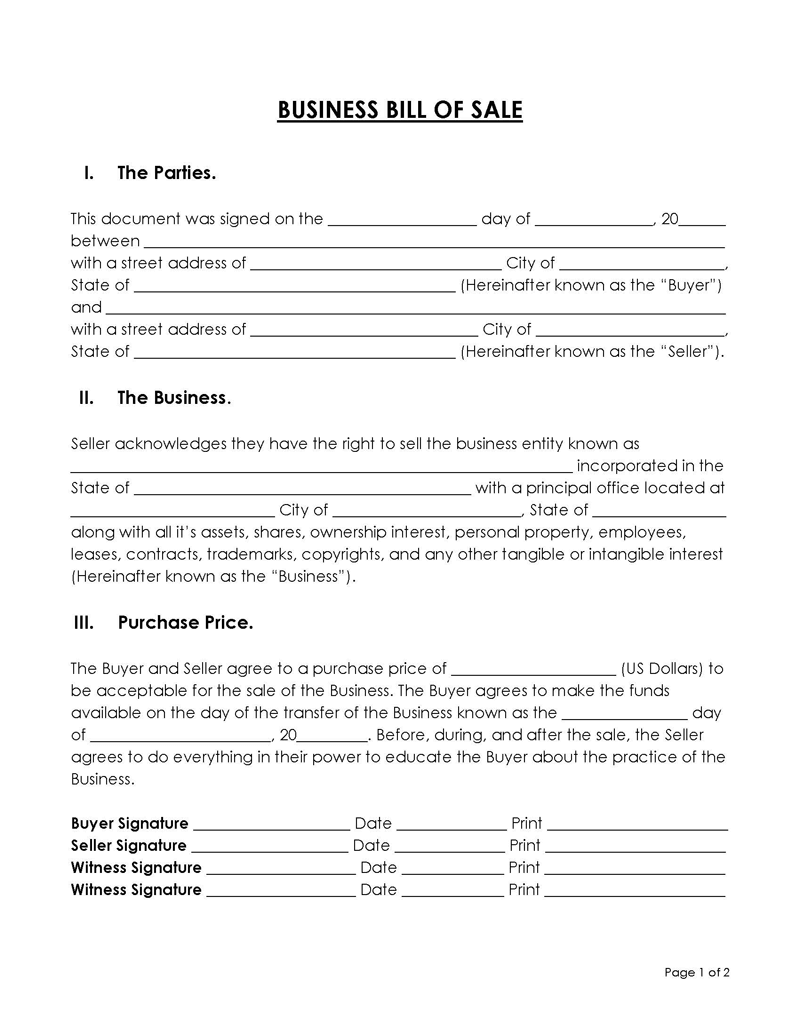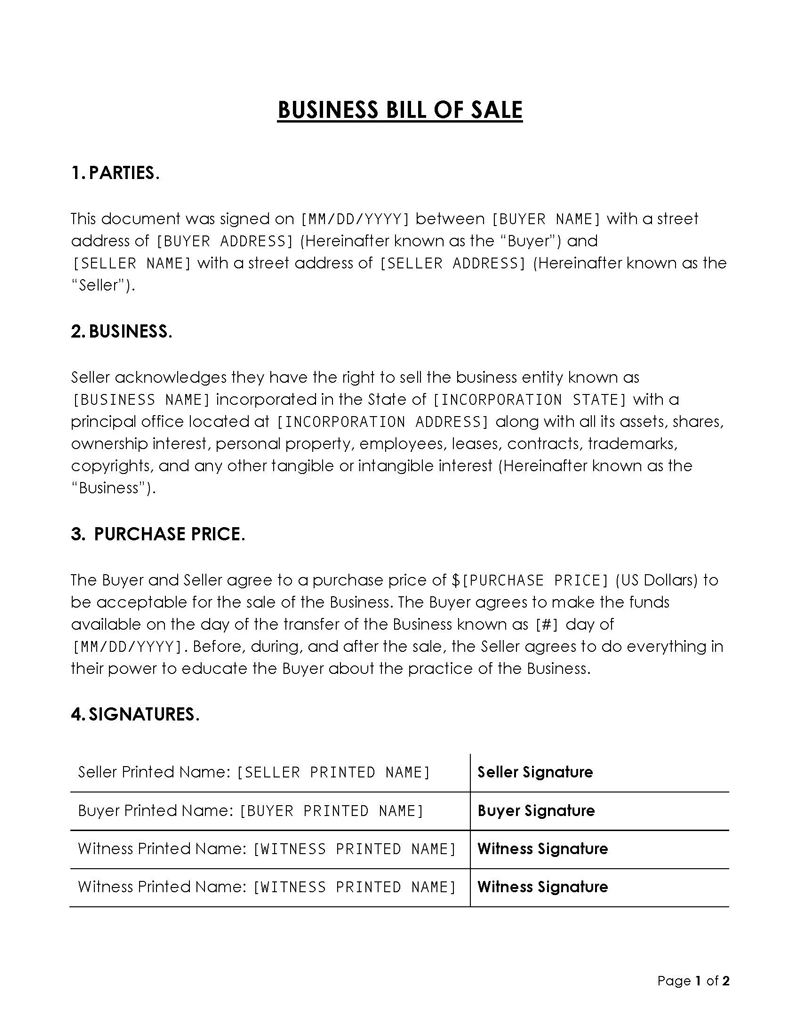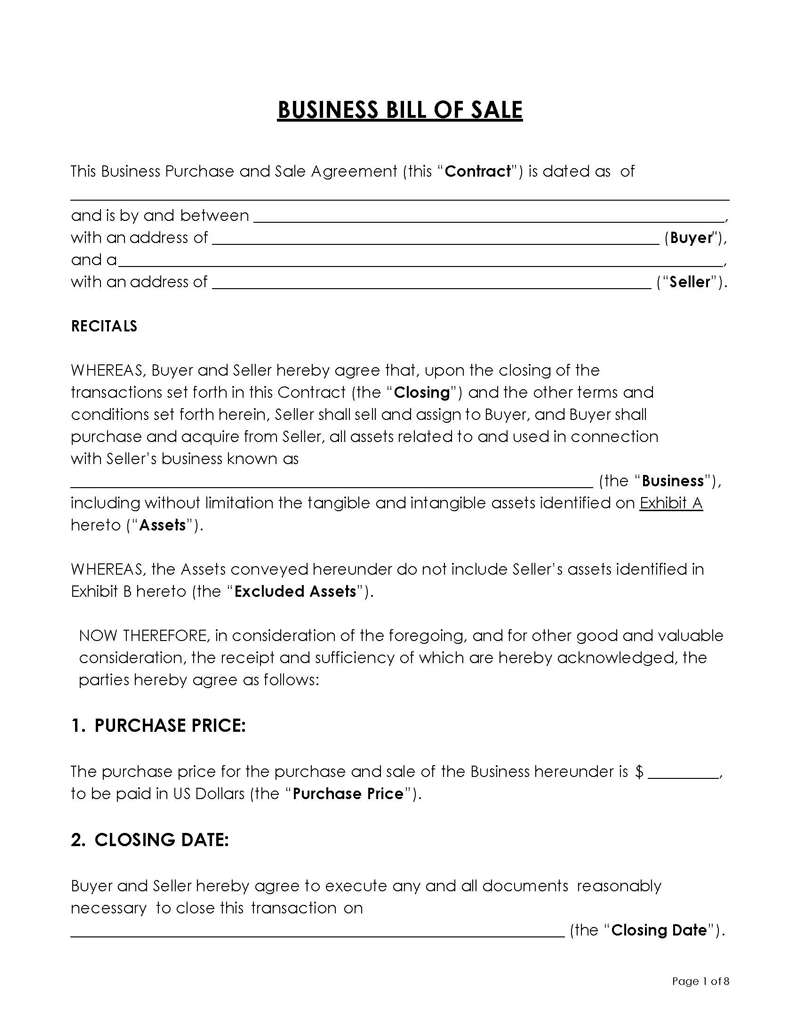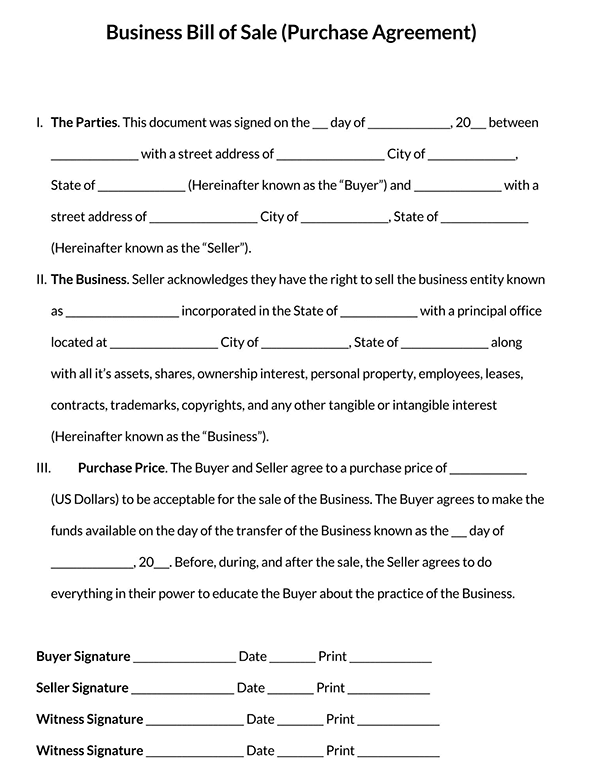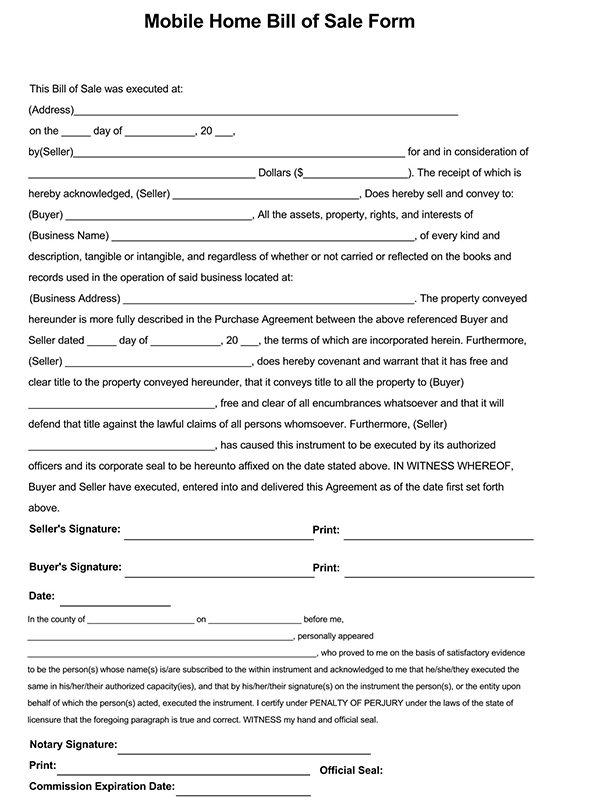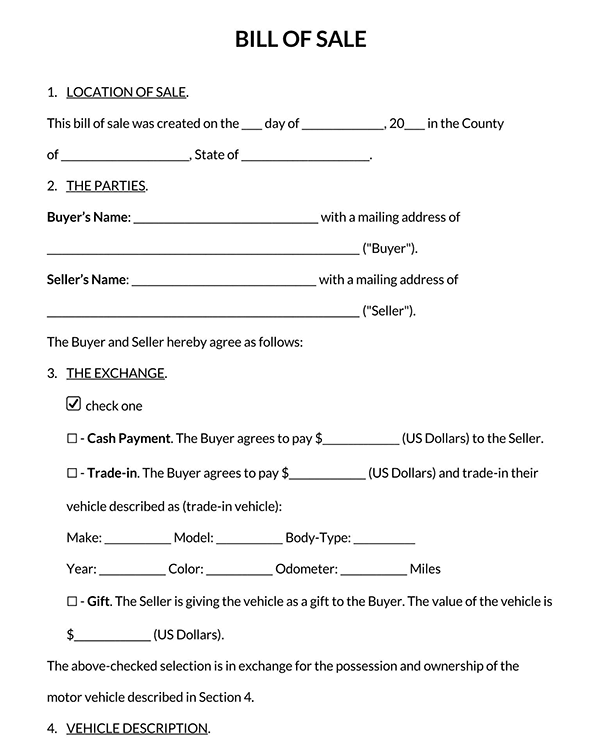A Business Bill of Sale Form is a legal document that details the transfer of ownership of a business from an individual or entity to another based on an agreed-upon set of terms.
Generally, a Bill of Sale helps facilitate a broad range of dealings like the sale of motor vehicles, houses, etc. The seller of a business normally drafts this document, and it specifies the details of the arranged transaction. Thus, the business bill of sale form usually carries more significance than the normal sale receipt. In addition, it serves to protect both the seller and buyer of a business in the event of a future dispute.
Executing a business bill of sale form usually comes with the agreement to sell the business “as-is”. Generally, the “as-is” condition emphasizes the current state of the asset under consideration and specifies that no guarantees or warranties come with the sale. It serves as proof that the buyer is content with the business’s condition at the time of purchase and protects the seller from requests for a refund from the buyer.
When to Use
A business bill of sale form is required in any situation where a party is looking to sell an item. This includes sales conducted on online platforms, sales of previously owned items, sales involving high-value items, etc.
The business bill of sale form gives protection to both parties involved in the transaction from any issues that may arise. Without this documentation, carrying out a sale makes it hard for the state to adjudicate if the situation arises. Some states like California recommend using a business bill of sale form when the asset under consideration is worth at least $500.
A business bill of sale form can also come into play when friends or families exchange gift items. In situations like this, it helps to clarify the ownership status of such an item, especially when trying to get insurance for the item.
For example:
A child who inherits a used car from his parents will need a business bill of sale form to prove ownership while registering, insuring the vehicle, or for tax purposes.
A business bill of sale form is also required when a seller needs to impose the “as-is” condition.
Bill of Sale vs. Purchase Agreement
A Bill of Sale is often confused with a Purchase Agreement. Superficially, the differences between the two documents are not very obvious. The two documents have their use in a sale transaction, and they usually both feature specific provisions. Nevertheless, there are fundamental differences in the purpose of the documents and the stages of a transaction when each is employed.
A Purchase Agreement is a contract that lays out the considerations involved in the future sale of an asset between a seller and a buyer. Even though the asset might exchange hands promptly after signing a Purchase Agreement, the key thing to note is that its usage is before the item on sale exchanges hands.
In the agreement, the seller clarifies the terms on which he agrees to sell the item and the terms on which the buyer agrees to make the purchase.
For example, a Purchase Agreement for the sale of a motor vehicle would specify the details about the type of vehicle, the brand, model, color, engine number, price, and mode of delivery, and make provision for return if the vehicle turns out to be different from the specifications in the agreement.
While the use of a Purchase Agreement is before the exchange of items, a Bill of Sale comes into effect during or after the exchange of items to formally transfer ownership. The Bill of Sale focuses more on identifying the exact items on sale and the validation of the seller’s actual right to transfer ownership of the item to the buyer.
The Bill of Sale can also feature warranties from the seller, depending on the terms negotiated. Where warranties are not in play, the seller can specify that items are sold without warranties and in “as-is” condition.
For example, in a motor vehicle sale, a seller will execute a Bill of Sale upon delivery of the motor vehicle to the buyer, indicating a transfer of ownership. The Bill of Sale, in this case, will function as a form of receipt, allowing the buyer to prove ownership of the vehicle anywhere.
What is the Business Bill of Sale Form?
The business bill of sale form contains terms and provisions that specify that a party has transferred their ownership in a business to another party. Based on the structure of the business, the transfer can include shares, stocks, or the whole business. It can also include assets owned by the business, which can constitute a substantial fraction of its value.
The form is introduced at the conclusion of the selling process, subsequent to the organization of the financials and the arrangement setup for transitioning. It can also include a provision requiring the seller to remain in an advisory role within the business for a specified amount of time to help guide and direct the activities of the new owners after the purchase.
Finally, the seller issues the business bill of Sale form, and it remains in possession of the buyer, serving as proof of ownership of the business. The form is applicable to the sale of any business type, including corporations, LLCs, partnerships, small enterprises, and non-profit making ventures.
Courts recognize the business bill of sale form as a legal agreement between two parties provided that it complies with the applicable state laws.
Essential Components of Bill of Sale
Components of a business bill of sale form can vary depending on the nature of the item on sale and the jurisdiction where the Bill of Sale is executed.
However, a business bill of sale form should typically feature the following information:
Date of sale
The correct date of the execution of the business bill of sale form must be included. The seller mustn’t make an error while registering the date in numerical day, written month, numerical year (last two digits), as an error can be a huge setback if a legal case arises.
Information of Seller and Buyer
The name, contact information, and addresses of the seller and buyer have to be present on the form. If either or both parties are a business entity, the business information should be used instead on the business bill of sale form.
Business details
In addition to a detailed description of the business, the form should feature the following information about the business:
- the official name of the business
- the state where the seller incorporated the business
- assets, shares, personal property, and other interests included in the business sale
Purchase price
The seller should specify the total financial value received for the business sale in written and numerical format.
Date of money transfer
In addition to the total amount received for sale, the form should feature the day, month, and year that the payment was received.
Signatures and dates from seller and buyer
Typically, both parties will need to append their signatures (and dates it was signed) to the document. However, some state laws require only the signature of the buyer. If uncertain, the seller should find out about the requirement in their jurisdiction to ensure compliance with the law and validity of the document.
Witnesses signature and name
While not many jurisdictions require witness signatures in a business bill of sale form, it is often a good idea to feature one or two witnesses to serve as evidence if there is ever a question of the validity of the business bill of sale form.
Notary Public Acknowledgement
Despite not being a requirement in most states in the United States, it is recommended that a seller secure the services of a notary to witness the document irrespective of the state. Taking this step helps to ascertain the validity of the document further. It also verifies the genuineness of the signatures of both parties and that there is an adequate understanding of what is being signed.
The notary acknowledgment form for a business bill of sale form should include the following information:
- County
- Date
- Notary’s Name
- Seller’s name
- Notary’s Signature
- Notary’s Printed Name
- Notary’s Commission Expiration Date
- Notary Seal
Free Templates
Following are some free downloadable business bill of sale form templates for you:
How to Sell a Business?
Several variables have to come into consideration when trying to sell a business. The process is a complex one, given that every business sale is unique. However, the basics remain the same, and there are verified approaches to having a successful sale. The more informed and prepared a seller is, the more likely it will achieve an optimal sale.
A seller can follow the steps given below to ensure a smooth process:
Estimate your business’ worth
A seller should estimate their business’s worth and thus must have a complete idea of the value of the business they are looking to sell. A business appraiser can be helpful for this purpose. The appraiser will put together a comprehensive explanation of the worth of the business while taking into consideration details like business sales, inventories, liabilities, and assets. The report attaches credibility to the asking price and can help the seller to set a price.
Compile the paperwork for the buyer
Proper organization and presentation of all the business documents are essential, as it facilitates the process for buyers. The seller should not omit any vital detail from the paperwork; he or she should be transparent as much as possible to avoid any future problems.
Accounting information
The seller should engage the services of an accountant or business consultant to carry out a review of the business’s financial reports and tax earnings in the last three to five years. In addition, the seller should be able to account for all business earnings within the period to avoid sending a red flag to the potential buyer. Prospective buyers would want to be sure that they put their money on a profitable business rather than one in distress.
While compiling the various financial reports, the list should include the following:
- Financial statements; profit and loss statements, balance sheets, loan documents
- Tax records dating back to the last three to four years
- Insurance records
- Records of employee benefits
Company details
Providing specific details about the business and its operations can score the seller a huge point with the prospective buyer. Business processes that are not well-laid out can do a lot to dissuade a potential buyer. The seller should make available documents that can highlight the day-to-day operations of the business across every department. This offers the buyer further insight into the business and gives the prospective buyer assurance that there is a working system in place.
The following documents will help provide these details:
- Operation manual for the business
- Record of employees, payroll, and security reports
- All patents and licenses
- Pictures of the business
- Assets to include in the business sale
- Marketing strategy, competitor research, and client information
- Property lease
- Financial statements and insurance forms
Legal paperwork
Furthermore, the seller must include all legal paperwork pertaining to the business.
This should include all types of contracts and agreements in place:
- Employee agreements
- Customer agreements
- Client and distributor contracts
For example:
- Revenue Documentation
- Profit Reports
- Expense Reports
- Non-Disclosure Agreement
- Letter of Intent
- Articles of Incorporation
- Partnership Agreement
- ROI Analysis
- Supplier Agreements
- Assignment of Licenses
- Assignment of Leases
- Stock Status
- Asset Acquisition Statement
In addition to these, it is in the seller’s best interest to implement a non-disclosure agreement during the negotiation process with prospective buyers. This is to help prevent sensitive information like trade secrets and business financials from falling into the wrong hands.
Advertise the business to buyers
After all the paperwork has been prepared and organized, the next line of action is to publicize the intent to sell. There are various avenues to list a business for sale, and the efficacy of each method depends on the nature of the business and the type of targeted customer.
For example, an area newspaper, online, or both, the business type, location, photos of the business location to attract the buyer, and purchase price should also be included.
Engaging the services of a business broker can also prove to be beneficial. Business brokers usually have access to networks of buyers specialized in business acquisition. Getting the opportunity to tap into these networks can be the difference between making a quick and good sale and making a “not so good” sale.
Meet the prospective buyers
Email communication is usually commonplace when it comes to business dealings. However, the sale of a business often requires skillful negotiations that are hardly demonstrable via email. The best way to go is to arrange a meeting to trash out all the details in real-time. It could be an in-person meeting or a virtual meeting.
Before setting up meetings, it is best to conduct a screening of prospective buyers so as not to waste too much time meeting with unlikely buyers. In addition, the seller should forward an easily accessible business information dossier to any prospective buyer before a meeting.
This helps to ensure that the parties do not spend more time than necessary deliberating on the basics during the meeting.
Finalize the sale
The endgame of the entire business sale process is to close a deal – a profitable deal. Leading up to this stage, the parties must have drafted and agreed on the terms of sale and the next line of action after the transfer of ownership.
For example, the terms may include a non-compete agreement, which forbids the seller from competing with the sold business for a specified period. Once all the terms have been finalized, the parties execute a business bill of sale form, signifying the official transfer of ownership of the business.
Final Words
The process of selling a business is never an easy one. To make it a tad less complex for the average seller and to avoid mistakes, it is always best to consult expert guides (such as this) that elucidate the entire process. Another option is to engage the services of a professional business broker to help facilitate the sale.
However, the business sale process’s complexity, or lack thereof, can boil down to the viability and validity of the business bill of sale form. A well-crafted business bill of sale form eases the entire business sale process by carefully setting out the terms of sale and functioning as a legitimate reference point in the event of a future dispute related to the business.

